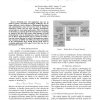Free Online Productivity Tools
i2Speak
i2Symbol
i2OCR
iTex2Img
iWeb2Print
iWeb2Shot
i2Type
iPdf2Split
iPdf2Merge
i2Bopomofo
i2Arabic
i2Style
i2Image
i2PDF
iLatex2Rtf
Sci2ools
IPPS
2010
IEEE
2010
IEEE
Performance modeling of heterogeneous systems
Predicting how well applications may run on modern systems is becoming increasingly challenging. It is no longer sufficient to look at number of floating point operations and communication costs, but one also needs to model the underlying systems and how their topology, heterogeneity, system loads, etc, may impact performance. This work focuses on developing a practical model for heterogeneous computing by looking at the older BSP model, which attempts to model communication costs on homogeneous systems, and looks at how its library implementations can be extended to include a run-time system that may be useful for heterogeneous systems. Our extensions of BSPlib with MPI and GASnet mechanisms at the communication layer should provide useful tools for evaluating applications with respect to how they may run on heterogeneous systems. I. PROBLEM DESCRIPTION The scalability of a parallel program is inherently connected with the performance parameters of the platform of execution. Matching ...
| Added | 13 Feb 2011 |
| Updated | 13 Feb 2011 |
| Type | Journal |
| Year | 2010 |
| Where | IPPS |
| Authors | Jan Christian Meyer, Anne C. Elster |
Comments (0)

